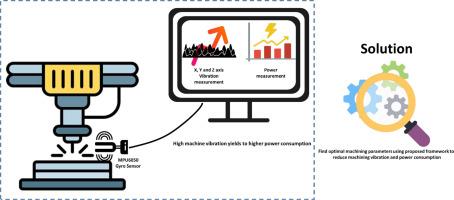Minimizing vibrations and power consumption in milling of AZ31 alloy through parameter optimization
IF 7.9
Q1 ENGINEERING, MULTIDISCIPLINARY
引用次数: 0
Abstract
This study presents an integrated optimization framework for minimizing vibration and power consumption during the milling of AZ31 magnesium alloy. A total of 25 experiments were performed using a Taguchi L25 orthogonal array to investigate the influence of spindle speed, feed rate, and depth of cut. Real-time data acquisition captured vibrations along the X, Y, and Z axes, as well as power consumption. Stepwise regression models were developed using Pearson’s correlation analysis, revealing spindle speed as the most influential parameter. These models were input into the NSGA-II algorithm, generating a Pareto front of optimal solutions. The best theoretical solution predicted vibration amplitudes of −8.2 mm (X), 7.7 mm (Y), 4.2 mm (Z), and a power consumption of 68.13 W. Experimental validation yielded errors of 4 % (X), 4 % (Y), 10 % (Z), and −6 % (power), confirming the model's accuracy. Correlation analysis indicated that spindle speed had the greatest influence on power consumption and Z-axis vibrations (r = 0.45 and r = 0.16), depth of cut significantly affected X-axis and Y-axis vibrations (r = 0.27 and r = 0.15) The framework effectively improves machining sustainability by optimizing process parameters.

通过参数优化,最大限度地减少AZ31合金铣削过程中的振动和功耗
提出了AZ31镁合金铣削过程中振动和功耗最小化的集成优化框架。采用田口L25正交试验,研究了主轴转速、进给速度和切削深度对加工精度的影响。实时数据采集捕获沿X、Y和Z轴的振动,以及功耗。采用Pearson相关分析建立逐步回归模型,发现主轴转速是影响最大的参数。将这些模型输入到NSGA-II算法中,生成最优解的Pareto前。最佳理论解预测振动幅值为−8.2 mm (X), 7.7 mm (Y), 4.2 mm (Z),功耗为68.13 W。实验验证产生的误差为4% (X), 4% (Y), 10% (Z)和- 6%(功率),证实了模型的准确性。相关分析表明,主轴转速对能耗和z轴振动的影响最大(r = 0.45和r = 0.16),切削深度对x轴和y轴振动的影响显著(r = 0.27和r = 0.15)。
本文章由计算机程序翻译,如有差异,请以英文原文为准。
求助全文
约1分钟内获得全文
求助全文
来源期刊

Results in Engineering
Engineering-Engineering (all)
CiteScore
5.80
自引率
34.00%
发文量
441
审稿时长
47 days
 求助内容:
求助内容: 应助结果提醒方式:
应助结果提醒方式:


